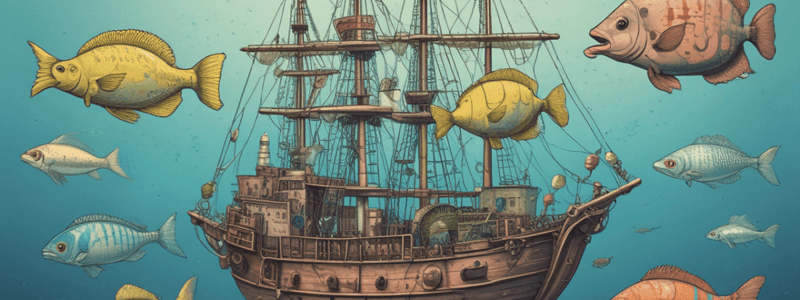Podcast
Questions and Answers
What is the primary mechanism by which lancelets draw water into their mouth?
What is the primary mechanism by which lancelets draw water into their mouth?
- Ciliary action (correct)
- Mucus-covered pharyngeal slits
- Muscular action
- Polysaccharide tunic
What is the characteristic of the tunicate larval stage that is not present in the adult stage?
What is the characteristic of the tunicate larval stage that is not present in the adult stage?
- Chordate body plan (correct)
- Free-swimming phase
- Sessile suspension feeding
- Tough polysaccharide 'tunic'
What is the function of the pharyngeal slits in lancelets?
What is the function of the pharyngeal slits in lancelets?
- To extract oxygen from the water
- To filter out particles from the water
- To expel water from the body
- To extract particles using mucus (correct)
What is the name of the opening through which water exits the lancelet body?
What is the name of the opening through which water exits the lancelet body?
Which group of animals is more closely related to vertebrates than to lancelets?
Which group of animals is more closely related to vertebrates than to lancelets?
What is the characteristic of adult tunicates?
What is the characteristic of adult tunicates?
What is a characteristic of chordates during embryonic development?
What is a characteristic of chordates during embryonic development?
What is the function of the tail in a running kangaroo?
What is the function of the tail in a running kangaroo?
What is the arrangement of muscle blocks in chordates?
What is the arrangement of muscle blocks in chordates?
Which group of chordates has a vertebral column?
Which group of chordates has a vertebral column?
What is the name of the subphylum that includes lancelets?
What is the name of the subphylum that includes lancelets?
What is the characteristic of lancelets that resembles bony fish?
What is the characteristic of lancelets that resembles bony fish?
What is the primary function of the notochord in invertebrate chordates?
What is the primary function of the notochord in invertebrate chordates?
Which of the following is a characteristic of chordates that is only evident during embryonic development for some chordate taxa?
Which of the following is a characteristic of chordates that is only evident during embryonic development for some chordate taxa?
What is the term for the study of animals that belong to clade Deuterostomia?
What is the term for the study of animals that belong to clade Deuterostomia?
What is the main difference between vertebrates and invertebrate chordates?
What is the main difference between vertebrates and invertebrate chordates?
What is the structure composed of a glycoprotein core sheathed in collagen fibers in chordates?
What is the structure composed of a glycoprotein core sheathed in collagen fibers in chordates?
How many groups of chordates are there?
How many groups of chordates are there?
Flashcards are hidden until you start studying
Study Notes
Lancelets
- Lancelets are marine sedentary suspension feeders that retain characteristics of the chordate body plan as adults.
- They wriggle backward into the sand.
- Water is drawn into the mouth by ciliary action and particles are extracted using mucus-covered pharyngeal slits.
- Water exits the body through the atriopore.
- Mucus net ingested (along with trapped food).
Tunicates
- Tunicates are more closely related to vertebrates than they are to lancelets.
- They are suspension-feeding marine invertebrate chordates (~2,100 spp.).
- Adults do not look like chordates.
- "Tadpole"-like larvae have a brief free-swimming phase.
- They attach to the substrate by the head.
- They metamorphose to adult body plan (lose chordate traits).
- They become sessile suspension feeders.
- Most adult tunicates are sessile, e.g., sea squirts/sea tulips that are permanently attached to rocks; other tunicates are pelagic.
- Tunicate larval stages most closely resemble the chordate body plan.
- The larval stage exhibits the four chordate shared, derived traits.
- Adult tunicates are covered by a tough polysaccharide "tunic".
Chordate Characteristics
- Chordates share a set of derived characters.
- Some traits are only evident during embryonic development for some chordate taxa.
- Shared, derived traits of chordates:
- Notochord
- Dorsal, hollow nerve cord
- Pharyngeal slits or clefts
- Muscular, post-anal tail
- Segmentation of chordates evolved independently from segmentation of other phyla, e.g., annelids and arthropods.
- Segmentation is considered a primitive character of clade Deuterostomia.
Segmentation
- Most chordates have segmented body plans, at least during embryonic development.
- The segments are often highly specialized into distinct body regions.
- Segmentally arranged muscle blocks are present in all adult chordates except in the Urochordata.
- Muscle blocks develop from blocks of mesoderm (somites) that flank the notochord.
- Muscle blocks are arranged in chevron (>>>) patterns.
- Alternating contractions of the muscle blocks cause the notochord/vertebral column to flex side-to-side → swimming in marine chordates!
Phylogeny of Living Chordates
- Chordates are bilaterian animals that belong to clade Deuterostomia.
- Chordates consist of all vertebrates and two groups of invertebrates, the urochordates and cephalochordates.
- The majority (>95%) of chordate species have vertebral columns (backbones): the vertebrates (subphylum Vertebrata).
Studying That Suits You
Use AI to generate personalized quizzes and flashcards to suit your learning preferences.




